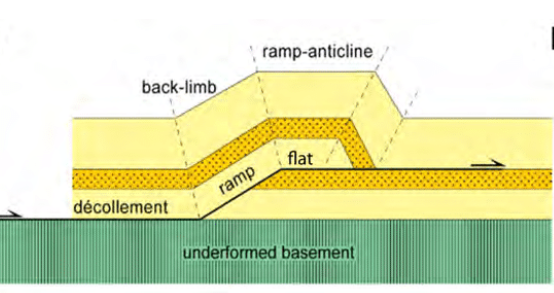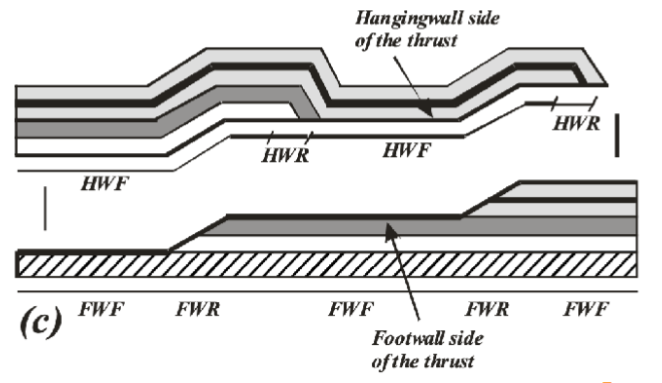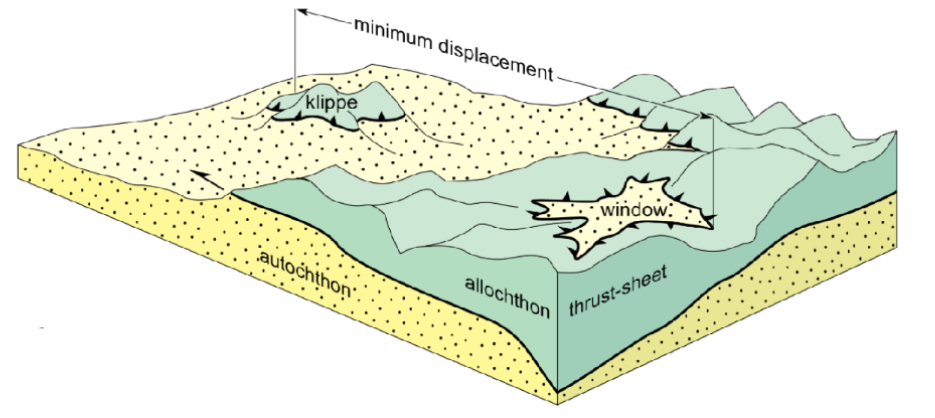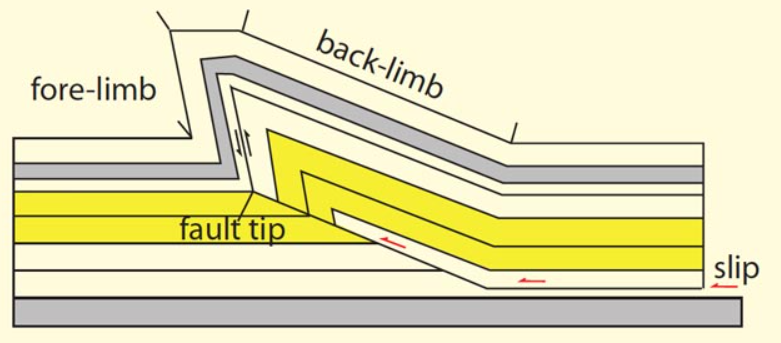RAMP FLAT THRUST GEOMETRY
Thrust surfaces usually have stair-case geometry.
FLAT
Sub-horizontal or gently-dipping (at the time of initiation) part of a thrust.
Fault segments running parallel to each other
RAMP
The moderately-dipping part (at the time of initiation) of a thrust.
Ramps usually climb up-section across stiffer layers.
Fault segments cutting across the beddings

Hanging wall flat (HWF): The portion of the thrust where the fault is parallel to the bedding surfaces on the hanging wall side.
Hanging wall ramp (HWR): The portion of the thrust where the fault is oblique to the bedding surfaces on the hanging wall side.
Footwall flat (FWF): The portion of the thrust where the fault is parallel to the bedding surfaces on the footwall side.
Footwall ramp (FWR): The portion of the thrust where the fault is oblique to the bedding surfaces on the footwall side.

Frontal ramp: Strike of the ramp is perpendicular to the regional tectonic transport direction.
Lateral ramp: Strike of the ramp is parallel to the regional tectonic transport direction.
Oblique ramp: Strike of the ramp is oblique to the regional tectonic transport direction.

THRUST VERGENCE
Thrust vergence refers to the direction towards which hanging wall moves relative to footwall.
Thrust faults are most common in fold-thrust belts (FTBs) typical of contractional orogenic setting.
The un-deformed sedimentary basin in front of an FTB is called foreland and the internal part of an FTB is known as hinterland.
FORELAND : towards transport direction
HINTERLAND : away from transport direction

Pop-up: Portion of hangingwall block that has been uplifted by a combination of forethrust and backthrust

Thrust sheet: In low angle thrusts, the areal extent of the hanging wall is much greater than thickness. Such a tabular- shaped hanging wall block is called a thrust sheet.
CHARACTERISTICS OF REVERSE FAULT
Thrust fault: a type of reverse fault with dip angle less than 450
Overthrusting : when hanging wall move relative to footwall
Underthrusting : when footwall move relative to hanging wall
Nappe:
thrust sheets with significant movement (>10 km) relative to footwall.
these are allochthonous rock units that has displaced from some distant places and rests upon an autochthonous rock unit
Klippe : remnant portion of nappe after erosion (Outlier)
Window : sometimes nappe may eroded deeply through which rocks below becomes visible known as window, (Inlier)

Root zone: The region in the hinterland direction where a thrust sheet passes into the subsurface is known as root zone.

Inlier : Older rocks are surrounded by younger rocks
Outlier : Younger rocks are surrounded by older rocks

THRUST SYSTEMS
Thrust systems are made up of group of link thrusts that are geometrically, kinematically and mechanically related
DUPLEX
Group of thrust linking a floor-thrust (sole thrust) at the base to a roof thrust at the top
Base : floor thrust or sole thrust
Top : roof thrust

IMBRICATES
A closely related array of thrusts all of which merge into a floor thrust is called imbricate thrust system
No roof thrust found

HORSE : A rock that is surrounded by all sides from fault
FAULT BENT FOLD
Ramp related fold in thrust fault
Ramp and fold formed simultaneously
Develops as the hanging wall of a thrust is transported through a ramp
Forelimb is shorter and steeper than backlimb
Backlimb is parallel to footwall ramp

FAULT PROPAGATION FOLD
Develops at the termination of a thrust
Fold formed after development ramp

OTHER TYPES
Decollement and Detachment faults are low angle faults

Comments
Post a Comment